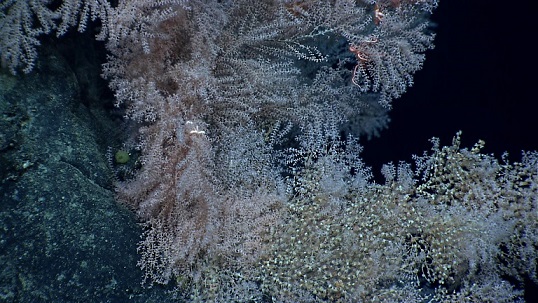WOOHOO! After 7 days of transit and mapping we FINALLY HAVE ARRIVED! Or more accurately we arrived last Wed. at the very base of the Emperor Seamount Chain. This location is still known to be fished by commercial trawlers, and is one of our “human impact” sites in the search to understand how octocorals recover from disturbances. Once we got on site we started mapping to help us pick an appropriate area within the guyot to then deploy the AUV Sentry.
AUV stands for Autonomous Underwater Vehicle, and is owned and operated by Wood’s Hole Oceanographic Institute (WHOI). The vehicle is preprogrammed with a dive plan, then sent out into the deep blue to survey! There are several instruments involved that keep Sentry a certain distance from the bottom and keep it from running into debris. Thus on a happily calm evening we were able to send Sentry out into the wilds.
We were able to keep sentry down for about 12 hours, but due to increasing wind and waves, we had to retrieve it a bit early. Unfortunately our calm period was not to last, and a pretty nasty storm is heading our way (we’re the green circle).
Sentry was greeted by a flock of albatross (anyone knows the species give me a shout!) who were sorely disappointed by the inedibility of our catch.
I’m super stoked to check out the images Sentry brought back, and example photos look incredibly detailed, to the point to where I’m hopeful for IDing corals to genus. The leaps in imaging technology make me so happy!
Once Sentry was onboard, we were also able to get the CTD rosette in the water before the winds made wench operations unsafe. The water crew is sampling for nutrients, chlorophyll, and radio-carbon. Fancy chemistry stuff! Maybe I can talk one of them to writing up a post about their research goals….hmmm. 🙂
Currently we are trying to stay out of the worst of the storm and mapping another location. 30 knot sustained winds! Thankfully the Sikuliaq is capable of handling much worse conditions – just makes for a bit of a bumpy ride! Hopefully we’ll get Sentry back in the water soon!














